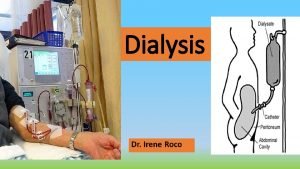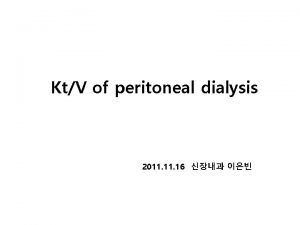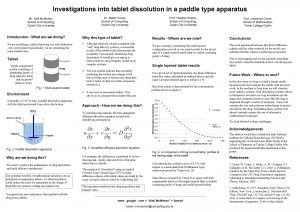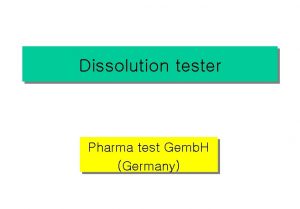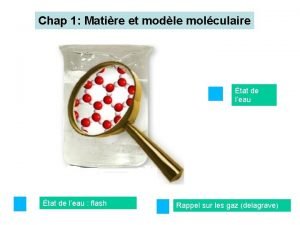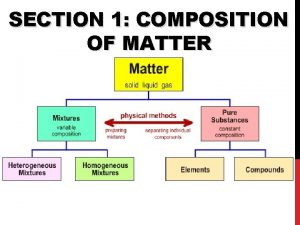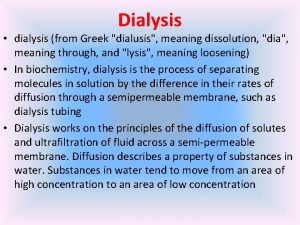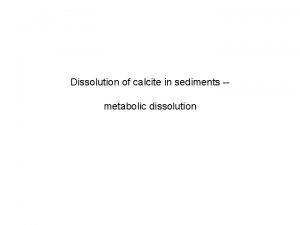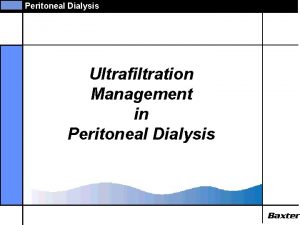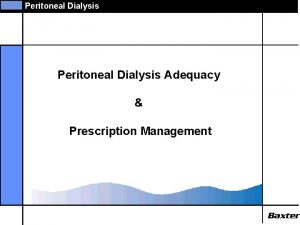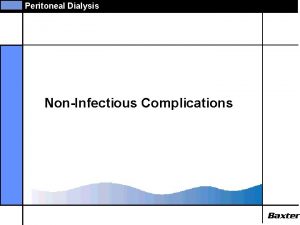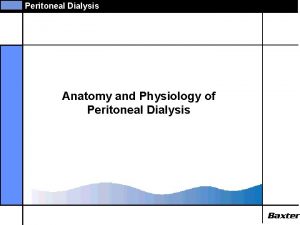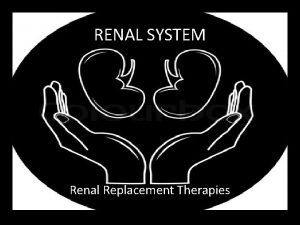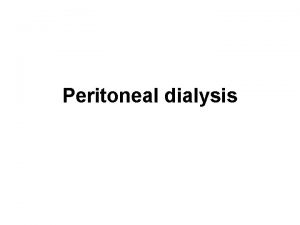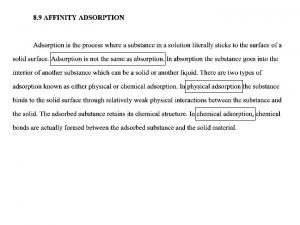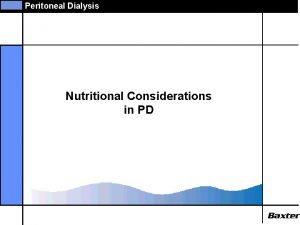Dialysis Dialysis from Greek dialusis meaning dissolution dia






















- Slides: 22

Dialysis

Dialysis • (from Greek dialusis, "", meaning dissolution, dia, meaning through, and lysis, meaning loosening or splitting) • is a process for removing waste and excess water from the blood and is used primarily as an artificial replacement for lost kidney function in people with kidney failure.

Purpose of Dialysis • is used to remove fluid and uremic waste products from the body when the kidneys cannot do so. • It may also be used to treat patients with edema that does not respond to treatment, hepatic coma, hyperkalemia, hypercalcemia, hypertension, and uremia.

Indications for Dialysis • The need for dialysis may be acute or chronic. 1. Acute dialysis is indicated A. when there is a high and rising level of serum potassium, fluid overload, or impending pulmonary edema, increasing acidosis, pericarditis, and severe confusion. B. to remove certain medications or other toxins (poisoning or medication overdose) from the blood. 2. Chronic or maintenance dialysis is indicated in chronic renal failure, known as end-stage renal disease (ESRD

Two main types of dialysis 1. HEMODIALYSIS • most commonly used method of dialysis for patients who are acutely ill and require short-term dialysis (days to weeks) • Indicated for patients with ESRD who require long-term or permanent therapy. • Patients receiving hemodialysis must undergo treatment for the rest of their lives or until they undergo a successful kidney transplant. • Treatments usually occur three times a week for at least 3 to 4 hours per treatment (some patients undergo short-daily hemodialysis; )

HEMODIALYSIS

Hemodialysis • removes wastes and water by circulating blood outside the body • The anticoagulant heparin is administered to keep blood from clotting in the dialysis circuit • The cleansed blood is then returned via the circuit back to the body • By the end of the dialysis treatment, many waste products have been removed, the electrolyte balance has been restored to normal, and the buffer system has been replenished.

Equipment for HEMODIALYSIS • Dialyzers (artificial kidneys) are either flat-plate dialyzers or hollowfiber artificial kidneys that contain thousands of tiny cellophane tubules that act as semipermeable membranes. • Dialysate - a solution with minerals (potassium and calcium) flows in the opposite direction with the blood circulating around the tubules

Principles of Hemodialysis • The objectives of hemodialysis are to extract toxic nitrogenous substances from the blood and to remove excess water. • In hemodialysis, the blood, loaded with toxins and nitrogenous wastes, is diverted from the patient to a dialyzer, in which is cleansed and then returned to the patient. 1. Diffusion – movement from higher concentration (blood) to lower concentration (dialysate). The toxins and wastes in the blood are removed 2. Osmosis - Excess water is removed from the blood by osmosis, in which water moves from an area of higher solute concentration (the blood) to an area of lower solute concentration (the dialysate bath). 3. Ultrafiltration - water moving under high pressure to an area of lower pressure by negative pressure or a suctioning force to the dialysis membrane.

Vascular Access • Access to the patient’s vascular system must be established to allow blood to be removed, cleansed, and returned to the patient’s vascular system at rates between 200 and 800 m. L/minute. • SUBCLAVIAN, INTERNAL, JUGULAR, AND FEMORAL CATHETERS • FISTULA - A more permanent access is created surgically (usually in the forearm) by joining (anastomosing) an artery to a vein, either side to side or end to side. The fistula takes 4 to 6 weeks to mature before it is ready for use • GRAFT - An arteriovenous graft can be created subcutaneously when the patient’s vessels are not suitable for a fistula; usually placed in the forearm, upper arm, or upper thigh.

Complications of Hemodialysis • During dialysis ( hypotension, arrhythmias, exsanguination, seizures, fever) • Between treatments (Hypertension/Hypotension, Edema, Pulmonary edema, Hyperkalemia, Bleeding, Clotting of access • Long term : Hyperparathyroidism, CHF, AV access failure, pulmonary edema, neuropathy, anemia, GI bleeding,

2. Peritoneal Dialysis • wastes and water are removed from the blood inside the body using the peritoneum as a natural semipermeable membrane. • Wastes and excess water move from the blood, across the peritoneal membrane, and into a special dialysis solution, called dialysate, in the abdominal cavity

Indications for Peritoneal Dialysis • Peritoneal dialysis may be the treatment of choice for patients with renal failure who are unable or unwilling to undergo hemodialysis or renal transplantation. • patients with diabetes or cardiovascular disease, • many older patients, and those who may be at risk for adverse effects of systemic heparin

Procedure for Peritoneal dialysis PREPARING THE PATIENT. 1. The nurse explains the procedure to the patient and obtains signed consent for it. 2. Baseline vital signs, weight, and serum electrolyte levels are recorded. 3. The patient is encouraged to empty the bladder and bowel to reduce the risk of puncturing internal organs. 4. Broad-spectrum antibiotic agents may be administered to prevent infection.

Procedure for Peritoneal dialysis PREPARING THE EQUIPMENT (apply Strict Aseptic technique ) 1. Consults the physician to determine the concentration of dialysate to be used and the medications to be added to it. (Heparin , Potassium chloride , Antibiotics’ Insulin). 2. Before medications are added, the dialysate is warmed to body temperature to prevent patient discomfort and abdominal pain and to dilate the vessels of the peritoneum to increase urea clearance. Solutions that are too cold cause pain and vasoconstriction and reduce clearance. Solutions that are too hot burn the peritoneum.

Procedure for Peritoneal dialysis PREPARING THE EQUIPMENT (apply Strict Aseptic technique ) 3. Assemble the administration set and tubing. Fill the tubing with the prepared dialysate to reduce the amount of air entering the catheter and peritoneal cavity, which could increase abdominal discomfort and interfere with instillation and drainage of the fluid. INSERTING THE CATHETER • Ideally, the peritoneal catheter is inserted in the operating room to maintain surgical asepsis and minimize the risk of contamination. In some circumstances, however, the physician inserts the catheter at the bedside under strict asepsis.

PERFORMING THE EXCHANGE (1 to 4 hours, depending on the prescribed dwell time. ) • Peritoneal dialysis involves a series of exchanges or cycles which is repeated throughout the course of the dialysis which is based on the patient’s physical status and acuity of illness. • An exchange is defined as the infusion, dwell, and drainage of the dialysate. INFUSION : The dialysate is infused by gravity into the peritoneal cavity for a period of about 5 to 10 minutes to infuse 2 L of fluid. DWELL: (equilibration time) allows diffusion and osmosis to occur. (peaks in the first 5 to 10 minutes )

PERFORMING THE EXCHANGE (1 to 4 hours, depending on the prescribed dwell time. ) DRAINAGE • The tube is unclamped and the solution drains from the peritoneal cavity by gravity through a closed system (10 to 30 minutes). • The drainage fluid is normally colorless or straw-colored and should not be cloudy. Bloody drainage may be seen in the first few exchanges after insertion of a new catheter but should not occur after that time. • The removal of excess water during peritoneal dialysis is achieved by using a hypertonic dialysate with a high dextrose concentration that creates an osmotic gradient ( Dextrose solutions of 1. 5%, 2. 5%, and 4. 25%).

NURSING RESPONSIBILITY • Maintain the cycle in a Strict aseptic technique • Vital signs, weight, intake and output, laboratory values, and patient status are frequently monitored. • Assesses skin turgor and mucous membranes to evaluate fluid status and monitor the patient for edema. • Facilitate drainage by turning the patient from side to side or raising the head of the bed, checking the patency of the catheter by inspecting for kinks, closed clamps, or an air lock. • Monitor for complications, including peritonitis, bleeding, respiratory difficulty, and leakage of peritoneal fluid.

NURSING RESPONSIBILITY • Measure abdominal girth to determine if the patient is retaining large amounts of dialysis solution. • Ensure that the peritoneal dialysis catheter remains secure and that the dressing remains dry. The catheter should never be pushed in. • Use a flow sheet to document each exchange and record vital signs, dialysate concentration, medications added, exchange volume, dwell time, dialysate fluid balance for the exchange (fluid lost or gained), and cumulative fluid balance

Complications of Peritoneal Dialysis • PERITONITIS (inflammation of the peritoneum) is the most common and most serious complication; characterized by cloudy dialysate drainage, diffuse abdominal pain, and rebound tenderness. • LEAKAGE of dialysate through the catheter site may occur immediately after the catheter is inserted • BLEEDING - common during the first few exchanges after a new catheter insertion because some blood exists in the abdominal cavity from the procedure. LONG-TERM COMPLICATIONS • Hypertriglyceridemia ; abdominal hernias (incisional, inguinal, diaphragmatic, and umbilical), hemorrhoids.

Reference: Brunner & Suddarth’s Medical Surgical Nursing Dr. Irene Roco
 Dialusis
Dialusis Oh que dia glorioso esse dia há de ser
Oh que dia glorioso esse dia há de ser Recuerdas aquel dia pues desde ese dia
Recuerdas aquel dia pues desde ese dia Senhor neste dia que amanhece venho pedir te a paz
Senhor neste dia que amanhece venho pedir te a paz Ktv formula
Ktv formula Molar solubility
Molar solubility Section 31 partnership act 1961
Section 31 partnership act 1961 Garner vs murray rule example
Garner vs murray rule example Committmebt
Committmebt Paddle type dissolution apparatus
Paddle type dissolution apparatus What are the factors that affect the rate of dissolution
What are the factors that affect the rate of dissolution Pharmatest dosage
Pharmatest dosage Dissolution
Dissolution Cariostat test
Cariostat test Caries susceptibility vs caries activity
Caries susceptibility vs caries activity Dissolution vs disintegration
Dissolution vs disintegration Partnership s
Partnership s Awareness exploration expansion commitment dissolution
Awareness exploration expansion commitment dissolution Dissolution curve
Dissolution curve Modèle particulaire dissolution
Modèle particulaire dissolution What is dissolution
What is dissolution Dissolution coefficient
Dissolution coefficient Fosdick calcium dissolution test
Fosdick calcium dissolution test
